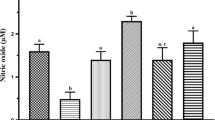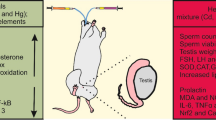Abstract
The aim of this study was to investigate the extent of lipid peroxidation when zinc is administered to rats periodically exposed to a 50-Hz electromagnetic field for 5 min at a time over a period of 6 mo. Twenty-four Sprague-Dawley adult male rats were subdivided in groups of eight animals each. Group 1 served as untreated controls, group 2 was exposed to an electromagnetic field but received no additional treatment, and group 3 was exposed to electromagnetic radiation and treated with 3-mg/kg daily intraperitoneal injections of zinc sulfate. The erythrocyte glutathione activity (GSH) and the plasma, testicle, and kidney tissue levels of zinc (Zn) and of malondialdehyde (MDA) were measured in all of the animals.
The plasma and testicle MDA levels in group 2 were higher than those in groups 1 and 3, with group 3 values significantly higher than those in group 1 (p<0.001). The kidney MDA levels in group 2 were higher than in groups 1 and 3 (p<0.001). The erythrocyte GSH level was lower in group 2 than in groups 1 and 3, with group 1 significantly lower than group 3 (p<0.001). In testicle and kidney tissues, the GSH levels in group 1 were lower than for groups 2 and 3, with group 2 significantly lower than group 3 (p<0.001) The plasma zinc levels were highest in group 3, followed by group 1 and group 2, which showed the lowest value (p<0.001).
These results indicate that testicle and kidney tissue damage caused by periodic exposure to an electromagnetic field are ameliorated or prevented by zinc supplementation.
Similar content being viewed by others

References
M. Yeniterzi, M. C. Avunduk, A. K. Baltaci, O. K. Aribas, N. Gormus, and E. Tosun, Histopathological changes in rats caused by magnetic field of 50 Hz frequency, Selcuk J. Med. 18, 38–51 (2002).
W. T. Kaune, T. Dovan, R. I. Kavet, D. A. Savitz, and R. R. Neutra, Study of high- and-low current configuration homes from the 1988 Denver Chaldhood Cancer Study, Bioelectromagnetics 23, 177–188 (2002).
M. A. Stuchly, D. W. Lecuyer, and J. McLean, Cancer promotion in a mouse-skin model by a 60-Hz magnetic field. I. Experimental design and exposure system, Bioelectromagnetics 12 261–271 (1991).
M. Yasui and Y. Otaka, Facility for chronic exposure of rats to ELF magnetic fields, Biolectromagnetics 14, 535–544 (1993).
D. A. Savits and D. P. Loomis, Magnetic field exposure in relation to leukemia and brain cancer mortality among electric utility workers, Am. J. Epidemiol. 141, 123–134 (1995).
D. L. McCormik, G. A. Boorman, J. C. Findlay, et al., Chronic toxicity/oncogenicity evaluation of 60 Hz (power frequency) magnetic fields in B6C3F1 mice, Toxicol. Pathol. 27, 279–285 (1999).
D. A. Savitz, D. Liao, A. Sastre, R. C. Kleckner, and R. Kavet, Magnetic field exposure and cardiovascular disease morality among electric utility workers, Am. J. Epidemiol. 149, 135–142 (1999).
C. F. Chignell and R. K. Sik, The effect of static magnetic fields on the photohemolysis of human erythrocytes by ketoprofen, Photochem. Photobiol. 67, 591–595 (1998).
A, Del Signore, P. Boscolo, G. Di Martino, and G. Giuliano, Combined effects of traffic and electromagnetic fields on the immune system of fertile atopic women, Ind. Health 38, 294–300 (2000).
Y. M. Moustafa, R. M. Moustafa, A. Belacy, S. H. Abou-El-Ela, and F. M. Ali, Effects of acute exposure to the radiofrequency fields of cellular phones on plasma lipid peroxide and antioxidase activities in human erythrocytes, J. Pharm. Biomed. Anal. 26, 605–608 (2001).
N. C. Blumenthal, J. Ricci, L. Breger, et al., Effects of low-intensity AC and/or DC electromagnetic fields on cell attachment and induction of apoptosis, Bioelectromagnetics 18, 264–272 (1997).
H. Shau, A. T. Kim, C. C. Hedrick, et al., Endogenous natural killer enhancing factor-B increases cellular resistance to oxidative stresses, Free Radical Biol. Med. 22, 497–507 (1997).
S. R. Powell, The antioxidant properties of zinc, J. Nutr. 130, 1447–1454 (2000).
A. Ozturk, E. Oztekin, A. K. Baltaci, A. Sivrikaya, E. Kurtoglu, and A. Kul, Effect of zinc deficiency and supplementation on MDA and GSH levels of blood and some tissues of rats performing swimming exercises, Balcan J. Clin. Lab. 8, 85 (2001).
P. I. Oteiza, V. N. Adonayle, and C. L. Keen, Cadmium-induced testes oxidative damages in rats can be influenced by dietary zinc intake, Toxicology 137, 13–22 (1999).
A. A. Shaheen and A. A. El-Fettah, Effects of dietary zinc on lipid peroxidation, glutathione, protein levels and superoxide dismutase activity in rat tissues, Int. J. Biochem. Cell. Biol. 27, 89–95 (1995).
H. H. Draper and M. Hadley, Malondialdehyde determination as index of lipid peroxidation, Methods Enzymol. 186, 421–430 (1990).
M. Uchiyama and M. Mihara, Determination of malondialdehyde precursor in tissues by thiobarbituric acid test, Anal. Biochem. 86, 271–278 (1997).
F. Atroshi and M. Sandholm, Red blood cell glutathione as a marker of milk production in field sheep, Res. Vet. Sci. 33, 256–258 (1981).
G. L. Ellmann, Tissue sulfhydryl groups, Arch. Biophys. 82, 70–77 (1959).
H. F. Goode, H. C. Cowley, B. E. Walker, P. D. Howdle, and N. R. Webster, Decreased antioxidant status and increased lipid peroxidation in patients with septic shock and secondary organ disfunction, Crit. Care. Med. 23, 646–651 (1995).
H. F. Galley, M. J. Davies, and N. R. Webster, Xanthine oxidase activity and free radical generation in patients with sepsis syndrome, Crit. Care. Med. 24, 1649–1653 (1996).
Y. Watanabe, M. Nakagawa, and Y. Miyakoshi, Enhancement of lipid peroxidation in the liver of mice exposed to magnetic fields, Ind. Health. 35, 285–290 (1997).
E. A. Romodanova, A. V. Paranich, and L. A. Chaikina, Effect of chronic effect of the electrostatic field on various biochemical indicators of the tissues, Fiziol. Zh. 36, 30–34 (1990).
A. N. Koterov and N. M. Shilina, Effect of zinc-metallothionein on lipid peroxidation in blood plasma and in mouse liver in acute alcoholic intoxication, Ukr. Biokhim. Zh. 67, 80–87 (1999).
M. O. Parat, M. J. Richard, J. C. Beani, and A. Favier, Involvement of zinc in intracellular oxidant/antioxidant balance, Biol. Trace. Element Res. 60, 187–204 (1997).
P. L. Oteiza, K. L. Olin, C. G. Fraga, and C. L. Keen, Oxidant defense system in testes from zinc deficient rats, Proc. Soc. Exp. Biol. Med. 213, 85–91 (1996).
G. Cao, Effects of zinc deficiency and supplements on lipid peroxidation and superoxide dismutase in mice, Zhonghua Yi Xue Za Zhi 71, 623–626 (1991).
L. Tahmaz, A. Gkalp, Y. Kibar, I. Kocak, O. Yalcin, and Y. Ozeren, Effect of hypothyroidism on the testes in mature rats and treatment with levothyroxine and zinc, Andrologica 32, 85–89 (2000).
Author information
Authors and Affiliations
Rights and permissions
About this article
Cite this article
Ozturk, A., Baltaci, A.K., Mogulkoc, R. et al. Zinc prevention of electromagnetically induced damage to rat testicle and kidney tissues. Biol Trace Elem Res 96, 247–254 (2003). https://doi.org/10.1385/BTER:96:1-3:247
Received:
Revised:
Accepted:
Issue Date:
DOI: https://doi.org/10.1385/BTER:96:1-3:247



